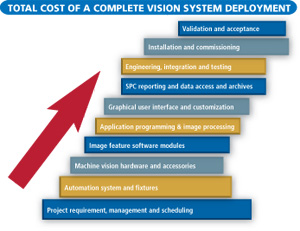
The gift of sight: Benefits obstacles and the deployment of vision technologies
March 24, 2006
By Joseph Poon
The machine vision systems market is growing, as more and more companies begin to use the technology to meet their ergonomic, quality control and regulatory needs.
Today, automatic vision inspection is being used in the industrial automation industry to streamline production, remove bottlenecks, increase throughput, save on labour costs and bolster productivity. Vision systems can work around the clock, resulting in peak production loads and faster order turn around. The systems can act as a substitute for human inspection when performing simple and repetitive jobs. This may avoid injury and costly mistakes that can be caused by human fatigue and bias brought on by the complacency of performing tedious and monotonous work. The technology can also become an effective quality control and data collection tool, since it delivers statistics, status and trends data.
Vision systems can provide real-time images, which enable users to monitor operations on-screen or to record digitized images with time stamps for later retrieval. Using these images as a diagnostic tool can assist troubleshooting, reduce downtime and eliminate losses from spoiled products.
Compliance is also a large contributor to the market’s growth. Most integrated vision systems today provide solutions that enable manufacturers to meet regulatory requirements. The systems provide product quality, safety and security inspection in manufacturing, as well as product tracking. These applications are driven by global regulatory and enforcement policies that demand due diligence towards 100 per cent inspection, and thus ensure product security and traceability from final packaging to delivery.
Regulatory compliance, especially for food and drug production, implies that somewhere along the production line a machine inspection system is required, rather than using the traditional human-based inspection station. Original equipment manufacturers are also beginning to require component and sub-component genealogy and traceability information from supply chain partners. Therefore, machine vision systems are designed in accordance with international quality standards such as FDA guidelines, 21 CFR Part 11, good manufacturing practice (GMP) and good automated manufacturing practice (GAMP). The systems play a critical role in enabling current and anticipated regulatory requirements in food and beverage, and pharmaceutical industries. Similarly, industries such as aerospace and automotive manufacturing face tightened requirements for unit level traceability for the sake of product liability, warranty costs and regulatory issues.
Despite the many applications and benefits, some manufacturers are still skeptical and hesitant to make investments in vision systems. Statistical reports show that a high percentage of new machine vision users have a hard time deploying the technology, since some real-world manufacturing conditions easily upset a vision system’s ability to “see.” These conditions include inconsistent lighting, and variations in component shapes and surface characteristics. In addition, a vision system will not receive widespread acceptance as an indispensable automation tool unless it delivers a promising performance, no matter how small a footprint it encapsulates and “smart” it promises to be.
Deployment guidelines
Current machine architecture is moving towards a more “intelligent” approach that strikes the right balance between cost and capabilities. One of the main thrusts of the emerging adaptive technology is to make vision systems easier to use, which means putting customized high-performance solutions into the hands of users without any development work on their part.
Adaptive technology for vision systems is part of an evolutionary progression that has improved user interaction with machines. The move to open standards and a Windows-based common interface has made systems more friendly and intuitive for inexperienced users. Using point-and-click tools on-screen to adjust parameters “on-the-fly,” without stopping the line, is as simple as operating a camcorder, but flexible enough to cope with process variations. Furthermore, multiple recipe-driven software programs with database management functions can easily support a flexible automation line and handle multiple product manufacturing. All of these flexible features are only available on PC-based machine vision systems.
Lastly, one should never overlook the cost to deploy and maintain a vision system before and after it is installed. Total cost of ownership (TCO) is a measure of all costs related to technology assets throughout their lifecycle, from acquisition to disposal. It is not as straightforward to determine some of these costs as one might first imagine, since many of these factors boil down to human issues, rather than the outlook of an initial hardware cost. The TCO puzzle is comprised of many pieces, from a big picture perspective. The diagram below shows a full spectrum of TCO elements that should be considered when deploying and maintaining a vision system in your plant.

As any industrial vision system depends on the weakest link within the whole technological chain, a homogeneous turnkey solution is the best approach to avoid failure in vision deployment plans. It is crucial that machine vision experts are involved throughout the entire development process so they can react to problems that occur and help companies anticipate unforeseen problems.
Companies that do not adopt machine vision technology as an integral part of their continuous improvement strategy will undoubtedly lose ground to companies whose competing products are virtually guaranteed by machine vision solutions. Facing a competitive global market, machine vision can empower a company with the means to successfully overcome the ever-increasing challenges of high labour costs, Third World competition and a market demand for quality products at a competitive price.
Joseph Poon, founder and president of Global Controls, has been in the field of machine vision for more than 15 years. He is also a consultant to ASM Pacific Ltd., an assembly equipment manufacturer for the global microelectronics industry.
Advertisement
- Road rules: Lessons learned from the seat of my Norton
- Sensor mining: Solving problems with your senses